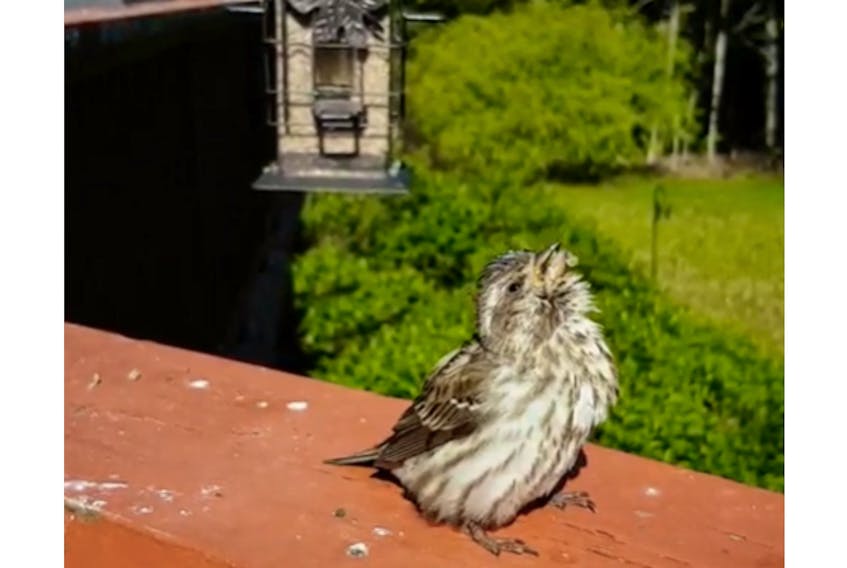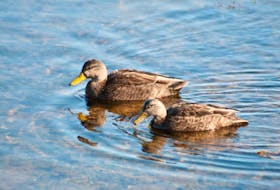Backyard birdwatchers in Prince Edward Island are being advised to be on the lookout for a deadly songbird disease.
This year’s first suspect case of trichomonosis was reported in Nova Scotia on June 16.
Trichomonosis is a disease caused by a parasite that attacks the upper digestive tracts of seed-eating birds.
Purple finch, goldfinch and pine siskin are the most commonly impacted species, said Dr. Laura Bourque, a wildlife pathologist with the Canadian Wildlife Heath Co-operative.
All of the research says the parasite is spread at feeders and birdbaths, so it may be a good idea to consider removing these elements from backyards for the summer months.

Trichomonosis arrived in the Maritimes in 2007 and has stuck around.
Some years have had more cases than others, but the number of cases has remained significant for the last four or five years, said Bourque.
“It seems like it’s here to stay," she said.
"It wouldn’t be inappropriate to call it an endemic disease now, which means it’s just a part of our environment.”
The Canadian Wildlife Health Co-operative is located at the laboratories at the Atlantic Veterinary College.
Along with other work, it takes in dead birds to check for the disease.
WATCH: Clinical signs of trichomonosis in songbirds
Trichomonosis impacts migratory songbirds, a population of birds already under pressure.
“There are many different types of threats and stressors that are placed upon migrating, breeding, reproductively-active songbirds during the course of their life,” said Bourque.
Cats, light pollution, window strikes and habitat destruction are just some of the threats they face on top of the disease, said Bourque.
“It’s one more stress placed on those poor birds," she said.
"They have very, very high metabolic demands during the summer and then in the fall they have to prepare for migration and, of course, all of that is a lot.”
Trichomonosis is a disease caused by a parasite that attacks the upper digestive tracts of seed-eating birds. Purple finch, goldfinch and pine siskin are the most commonly impacted species
Experts don’t know just how many birds die from the parasite each year.
“The cases that I see are just the tip of the iceberg,” said Bourque, adding that trichomonosis is an awful disease.
“These birds basically slowly die – and painfully die – because of this infection of their upper gastro-intestinal tract.”
Dan McAskill, an avid birdwatcher, keeps his eye on information from around the Maritimes watching for alerts about trichomonosis cases.
Regardless of the presence of trichomonosis, feeders should be washed, disinfected and dried regularly, said McAskill.
“In warm weather, the odds of an outbreak increase,” said McAskill.
“There’s usually a progression across the Maritimes.”
Feeder hygiene:
- Clean bird feeders and bird baths regularly with a 10 per cent solution of domestic bleach. Feeders should be rinsed well and dried before re-use.
- To make a 10 per cent solution add a scant half-cup of household bleach to four cups of water or just over 1.5 cups of bleach to a U.S. gallon of water.
Birdwatchers should always monitor the birds at their feeders for signs of disease and take in birdbaths and feeders if the parasite is present.
Dispose of any birdseed in the feeders into the waste stream, said McAskill.
McAskill and Bourque said to consider not feeding birds in the summer.
The chances of disease spread go up and there are enough natural food sources to maintain the population.
“Hummingbird feeders are OK to stay out,” said McAskill.
FAST FACTS:
- Trichomonosis infects songbirds like purple finches, goldfinches and pine siskins.
- The disease is caused by a parasite known as trichomonas gallinae. It’s also known as called trichomoniasis, canker or frounce
- Bird feeders and baths are thought to cause the spread of the disease.
- Trichomonosis causes severe damage to the tissues of the mouth, throat, crop and esophagus.
- Affected birds may drool saliva, regurgitate food, have difficulty swallowing food and water, demonstrate laboured breathing and/or have a swollen neck or throat.
- Affected finches often have matted, wet plumage around the face and beak, presumably due to regurgitation.
- During a known outbreak of trichomonosis, bird feeders and artificial water sources should be put away until after the first prolonged cold weather and frost of the winter. During the summer months, there is plenty of natural food and water available for birds.
- Only use bird feeders that prevent the seed from getting wet.
- Do not use table feeders. Sick birds sitting directly on bird seed are more likely to contaminate it with trichomonas gallinae.
- Report any sick or dead birds to the Canadian Wildlife Health Cooperative Atlantic office at 902-628-4314.
Alison Jenkins is a local journalism initiative reporter, a position funded by the federal government.









